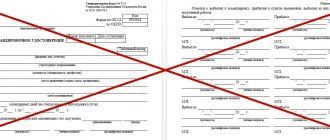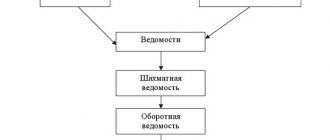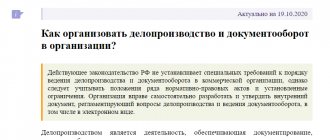Unregulated advertising expenses
The list of advertising expenses recognized by the Tax Code of the Russian Federation in full is strictly limited.
If an organization’s advertising expenses can be attributed to one of the groups listed above, then they reduce the tax base in full when calculating income tax. It should be noted that in paragraph 4 of Art. 264 only brochures and catalogs are indicated. Despite the fact that the Ministry of Finance of the Russian Federation considers booklets, flyers and leaflets to be a type of advertising brochures, disputes about classifying them as non-standardized expenses are not excluded.
Let us note some nuances that must be taken into account when accepting non-standardized advertising expenses for accounting, i.e., including the full amount of expenses.
- To accept advertising expenses in the media as such, you need a copy of the certificate of registration as a media outlet of the counterparty placing your advertisement.
- The Ministry of Finance of the Russian Federation in its letter dated June 15, 2011 No. 03-03-06/2/94, referring to Art. 16 of the Law “On Advertising” dated March 13, 2006 No. 38-FZ, indicated: in order for an advertisement published in a print publication that does not work on advertising to be considered with features suitable for advertising standards in print media, it must include the appropriate label - “ Advertising" or "On the basis of advertising".
- If an advertising product, for example a billboard, has a cost of over 100,000 rubles. and is intended for use longer than 12 months, then the costs for it are taken into account through depreciation charges.
There is increased interest among tax authorities in assessing non-standardized advertising expenses. In order to avoid deduction of advertising expenses in full, the accountant must be scrupulous with the documents confirming non-standardized advertising expenses. The main requirement, in addition to those generally accepted for primary documents, is confirmation that these expenses are included in those mentioned in paragraph 4 of Art. 264 Tax Code of the Russian Federation.
If you have access to ConsultantPlus, check whether you are correctly taking into account advertising costs when calculating taxable income. If you don't have access, get a free trial of online legal access.
General audit department on the issue of VAT taxation of advertising materials
Answer According to subparagraph 1 of paragraph 1 of Article 146 of the Tax Code of the Russian Federation, the object of VAT taxation is the sale of goods on the territory of the Russian Federation. For VAT tax purposes, the transfer of ownership of goods free of charge is recognized as the sale of goods.
According to paragraph 1 of Article 39 of the Tax Code of the Russian Federation, the sale of goods is recognized as the transfer of ownership of goods on a paid or gratuitous basis.
Thus, by virtue of the above rules, for the purposes of VAT taxation, the sale of goods is recognized as their transfer to a third party, both on a compensated and gratuitous basis.
Article 149 of the Tax Code of the Russian Federation provides for a list of transactions not subject to VAT.
According to subparagraph 25 of paragraph 3 of Article 149 of the Tax Code of the Russian Federation, the operation of transferring goods for advertising purposes, the costs of purchasing (creating) units of which do not exceed 100 rubles, is not subject to taxation on the territory of the Russian Federation
.
In other words, this operation is recognized as an object of VAT taxation
, but due to the direct norm of Article 149 of the Tax Code of the Russian Federation, it is not subject to VAT.
Accordingly, in our opinion, the transfer of materials for advertising purposes, the acquisition costs of which exceed 100 rubles, is subject to VAT on a general basis. The Ministry of Finance of the Russian Federation adheres to a similar opinion in Letters dated July 16, 2012. No. 03-07-07/64, dated 06/04/2013. No. 03-03-06/2/20320.
For the lawful application of the benefit under subparagraph 25 of paragraph 3 of Article 149 of the Tax Code of the Russian Federation, the taxpayer must confirm that the transfer of goods to a person was made for advertising purposes, otherwise the transfer of goods to a third party is subject to taxation on the basis of subparagraph 1 of paragraph 1 of Article 146 of the Tax Code of the Russian Federation.
In accordance with paragraph 1 of Article 3 of the Federal Law of March 13, 2006 No. 38-FZ “On Advertising” (hereinafter referred to as Federal Law No. 38-FZ), advertising means information disseminated in any way, in any form and using any means addressed to an indefinite number of people and aimed at attracting attention to the object of advertising
, creating or maintaining interest in it and promoting it on the market.
Under the object of advertising
means a product, a means of individualization of a legal entity and (or) a product, a manufacturer or seller of a product, results of intellectual activity or an event (including a sports competition, concert, competition, festival, risk-based games, bets) aimed at attracting attention to which advertising (clause 2 of article 3 of Federal Law No. 38-FZ).
In accordance with the explanations of the FAS in the Letter dated 04/05/2007. No. AC/4624:
“...by an indefinite circle of persons we mean those persons who cannot be determined in advance as the recipient of advertising information and a specific party to the legal relationship arising in connection with the sale of the object of advertising. Such a sign of advertising information as its intended for an indefinite number of people means the absence in the advertisement of an indication of a certain person or persons for whom the advertisement was created and to whose perception the advertisement is directed.
Accordingly, the distribution of such non-personalized information about a person, product, or service should be recognized as distribution among an indefinite circle of persons, including in cases of distribution of souvenirs with a logo
organizations
as gifts
, since it is impossible to determine in advance all the persons to whom such information will be communicated"
Taking into account the above, in our opinion, the transfer of goods in the cases indicated by you is carried out for advertising purposes, with the exception of cases where the prizes (gifts) do not have the Organization’s logo printed on them.
It should be noted that today the position of the Supreme Arbitration Court has been formed regarding the VAT taxation of transactions involving the transfer of goods for advertising purposes, the purchase costs of which exceed 100 rubles. Clause 12 of the Plenum of the Supreme Arbitration Court of the Russian Federation dated May 30, 2014. No. 33 o.
Thus, the Plenum of the Supreme Arbitration Court clarified that when transferring goods for advertising purposes, the cost of purchasing a unit of which exceeds 100 rubles, an object of VAT taxation arises. At the same time, the transfer of advertising materials that do not meet the characteristics of the product does not form an independent object of taxation.
As follows from paragraph 3 of Article 38 of the Tax Code of the Russian Federation, a product for the purposes of applying the norms of the Tax Code of the Russian Federation
any
property being sold or intended for sale
.
Resolution of the Federal Antimonopoly Service of the Moscow District dated December 8, 2010 No. KA-A40/15275-10 in case No. A40-13946/10-109-27 states:
“...By virtue of clause 3 of Art. 38 of the Tax Code of the Russian Federation, a product for the purposes of the Code is any property sold or intended for sale.
Because catalogs have no use value for the recipient
, are by virtue of clause 2 of Art.
497 of the Civil Code of the Russian Federation as a means of familiarizing the buyer with the description of the goods proposed by the seller, the courts made a reasonable conclusion that catalogs themselves are not goods
, and therefore their direct mailing does not form an object of taxation with value added tax...”
Resolution of the Federal Antimonopoly Service of the Moscow District dated July 11, 2011 N KA-A40/6881-11 in case No. A40-116981/10-127-627 states:
“...Thus, the courts came to a reasonable conclusion that a catalog sent to a potential buyer by mail, which contains the conditions for the purchase of goods described in the catalog itself, and the order form for these goods is not itself a product
, sold by the Company to individuals, and the catalog acts as an offer - an offer to a potential buyer to place an order for the purchase of one or more goods listed in the catalog by filling out an order form and sending it to the seller.
In this regard, it is reasonable for the courts to conclude that catalogs do not have consumer value for the recipient, but are a means of familiarizing the buyer with the description of the goods offered by the seller; catalogs themselves are not goods in this legal situation, therefore their direct mailing does not form an object VAT taxation..."
Resolution of the Federal Antimonopoly Service of the Moscow District dated July 19, 2011 N K-A40/7294-11 in case No. A-40-118810/10-127-644 o.
Thus, as follows from the analysis of judicial practice, advertising materials that do not have consumer value for the recipient
and
cannot be sold or are not intended for sale on the market
and
do not meet the characteristics of the product.
In your case, in our opinion, such advertising materials may include your product catalogs and leaflets, i.e. their transfer for advertising purposes does not form an object of taxation for VAT purposes, regardless of the purchase price.
It should be noted that the Ministry of Finance of the Russian Federation in its Letter dated October 25, 2010. No. 03-07-11/424 expressed the opposite point of view: “... Thus, the transfer for advertising purposes of catalogs containing information about the goods sold is subject to value added tax in the generally established manner...”.
However, in order to form a unified law enforcement practice, the Ministry of Finance of the Russian Federation in the Letter of the Russian Federation dated November 7, 2013. No. 03-01-13/01/47571 noted the following:
“...According to paragraph 1 of Article 34.2 of the Tax Code of the Russian Federation, the Ministry of Finance of Russia provides written explanations to the tax authorities on the application of the legislation of the Russian Federation on taxes and fees.
Based on subparagraph 5 of paragraph 1 of Article 32 of the Tax Code of the Russian Federation, tax authorities are required to be guided by written explanations of the Ministry of Finance of Russia on the application of the legislation of the Russian Federation on taxes and fees.
At the same time, letters from the Ministry of Finance of Russia, which explain the application of the legislation of the Russian Federation on taxes and fees, do not contain legal norms, do not specify regulatory requirements and are not regulatory legal acts. These letters are of an informational and explanatory nature on the application of the legislation of the Russian Federation on taxes and fees.
In the event that written clarifications of the Ministry of Finance of Russia (recommendations, clarifications of the Federal Tax Service of Russia) on the application of the legislation of the Russian Federation on taxes and fees are not consistent with
decisions,
decrees
, information letters
of the Supreme Arbitration Court of the Russian Federation,
as well as decisions, decrees, letters of the Supreme Court of the Russian Federation,
tax authorities, starting from the day the specified acts and letters of the courts are posted in full on their official websites on the Internet or with the day of their official publication in the prescribed manner, when exercising their powers, they are guided by the specified acts and letters of the courts
.”
Thus, tax authorities in the course of tax control activities are not guided by the explanations of the Ministry of Finance of the Russian Federation, which do not agree with the opinion expressed in the Resolution of the Plenum of the Supreme Arbitration Court.
In addition, as follows from paragraph 2 of Art. 13 of the Federal Constitutional Law of April 28, 1995 No. 1-FKZ “On Arbitration Courts in the Russian Federation”, on issues within its jurisdiction, the Plenum of the Supreme Arbitration Court of the Russian Federation adopts decisions that are binding on arbitration courts in the Russian Federation.
Consequently, the specified position of the Plenum of the Supreme Arbitration Court of the Russian Federation is binding for all arbitration courts in the Russian Federation.
Thus, today the position of the Supreme Arbitration Court of the Russian Federation has been formed regarding the taxation of transactions for the transfer of goods for advertising purposes, expenses for the acquisition of which exceed 100 rubles, which lower courts should be guided by when resolving disputes. Thus, we do not rule out that if the Organization decides not to impose VAT on the transfer of goods for advertising purposes in the cases indicated by you, the outcome of the trial will not be in your favor.
However, before the Resolution of the Plenum of the Supreme Arbitration Court came into force, in most cases, disputes with the tax authorities were in favor of the taxpayer, as evidenced by arbitration practice, where the courts came to the conclusion that the transfer of products for advertising purposes is not subject to VAT.
Thus, the Resolution of the Federal Antimonopoly Service of the Moscow District dated June 25, 2010 No. KA-A40/6610-10 states:
“According to paragraphs. 7 and 8, paragraph 4 of the inspection decision, the cost of advertising or souvenir products (the cost of purchasing a unit of which exceeds 100 rubles), donated during promotions, is subject to VAT taxation.
Having pointed out that the company had not provided evidence
confirming the paid nature of the transfer of ownership of goods distributed during promotions, the inspectorate assessed additional VAT on such sales.
In accordance with subparagraph 6 of paragraph 1 of Article 253 of the Code, expenses associated with production and sales include other expenses associated with production and sales, which in turn, in accordance with subparagraph 28 of paragraph 1 of Article 264 of the Code, include expenses for advertising products produced (purchased) and (or) sold goods (works, services), activities of the taxpayer, trademark and service mark, including participation in exhibitions and fairs, taking into account the provisions of paragraph 4 of this article.
Taxpayer expenses for other types of advertising are recognized in an amount not exceeding one percent of sales revenue, determined in accordance with Article 249 of the Code (paragraph 5 of paragraph 4 of Article 264 of the Tax Code of the Russian Federation).
Tax legislation does not provide a definition of the concept of “gratuitous transfer”, therefore, according to Article 11 of the Tax Code of the Russian Federation, it is necessary to use this concept, which is used in other areas of legislation.
In accordance with Article 572 of the Civil Code of the Russian Federation, under a gift agreement, one party (the donor) gratuitously transfers or undertakes to transfer to the other party (the donee) an item of ownership or a property right (claim) to himself or a third party, or releases or undertakes to release it from property obligations to yourself or to a third party. If there is a counter transfer of a thing or right or a counter obligation, the contract is not recognized as a donation.
Consequently, we can talk about the gratuitous nature of the transfer if the donee does not commit any reciprocal actions.
As the courts of first and appellate instances established, in this case, in order to form a viewership that corresponds to the new concept of the TV channel and attract new advertisers, promote services, the company produced and distributed advertising products among potential advertisers and partners of the company, namely: mp3 players with engraving in the form an individualization sign for the society's TV channel and a T-shirt with the society's logo.
As a result of this distribution, society received the opposite idea
in the form of attracting interest to the TV channel, increasing its recognition among potential clients and expanding the TV channel’s audience.
Consequently, the transfer of products for advertising purposes of an organization is not a gratuitous transaction and is not subject to inclusion in the object of taxation in accordance with subparagraph 1 of paragraph 1 of Article 146 of the Tax Code of the Russian Federation, and the tax authority had no reason to charge additional VAT on such transactions.”
The Federal Antimonopoly Service of the Moscow District, in Resolution No. KA-A40/10351-09 dated October 6, 2009, provides another argument in favor of not subjecting these transactions to VAT:
“The courts, having examined the evidence presented in the case, found that the Company during the audited period transferred goods for the purpose of advertising its activities, while the turnover of the distribution of goods during the advertising campaign is not subject to VAT, since the cost of advertising goods was included by the applicant in the total price of goods, the Company’s advertising costs are included in the expenses taken into account when calculating income tax
, as advertising expenses, in connection with which, applying sub.
1 clause 1 art. 146, sub. 28 clause 1 art. 264 of the Tax Code of the Russian Federation, the courts concluded that the tax authority had unlawfully charged additional VAT on goods written off during the promotion
.”
The Supreme Arbitration Court of the Russian Federation in its Determination No. 17088/07 dated December 24, 2007 indicated:
“In order to create a positive image and successfully carry out a contractual campaign, the company organized advertising events, during which it donated advertising products (booklets, calendars, pens) to potential consumers at fairs and exhibitions. The company paid for advertising products taking into account the value added tax; advertising costs were included in the cost of the goods sold, on which the taxpayer pays the specified tax.
Based on the foregoing, the courts came to the conclusion that the advertising products in this case were not sold by the company, but only contributed to the sale of manufactured products.”
Decisions in favor of taxpayers were also made in the Resolution of the Supreme Arbitration Court of the Russian Federation dated 04.04.08 No. 4419/08, Resolutions of the Federal Antimonopoly Service of the Russian Federation dated 24.11.06 No. A82-9118/2005-99, FAS SKO dated 13.11.06 No. F08-5401/2006-2246A .
Thus, the courts, refuting the arguments of the tax authorities about the gratuitous transfer of goods for advertising purposes, proceeded from the following:
1. The purpose of the advertising campaign is to attract attention to the activities of organizations (goods, works, services). In response to advertising campaigns, organizations plan to attract additional clients. Accordingly, from this point of view we can talk about the paid nature of the advertising campaign. In addition, in their opinion, the sale of promotional goods as such does not occur in this case.
2. In the case of transferring materials for advertising purposes, such materials do not have any value for the recipient, i.e. have no market value, but are aimed solely at attracting attention to the activities of the organizations themselves. Due to the lack of market value, there is no basis for calculating VAT amounts on the cost of donated materials.
3. In accordance with paragraph 16 of Article 270 of the Tax Code of the Russian Federation, expenses in the form of gratuitously transferred property are not taken into account for profit tax purposes.
However, the costs of advertising campaigns, among other things, are taken into account as advertising expenses, which is not disputed by the Ministry of Finance of the Russian Federation and the tax authorities.
Accordingly, from the point of view of Chapter 25 of the Tax Code of the Russian Federation, this operation is not recognized as a gratuitous transfer of goods.
It is logical to assume that it will not be recognized as a gratuitous transfer from the point of view of Chapter 21 of the Tax Code of the Russian Federation, since the criteria for recognizing a gratuitous transfer for both income tax and VAT are the same.
4. When carrying out an operation to transfer materials for advertising purposes, the recipients of the materials are unknown, which indicates the absence of a recipient under the gift agreement, and therefore this operation cannot be considered as a gratuitous transfer.
And do we have the right to offset input VAT when purchasing the above-mentioned values, if their cost is below 100 rubles? a piece.
Based on subparagraph 1 of paragraph 2 of Article 170 of the Tax Code of the Russian Federation, tax amounts presented to the buyer when purchasing goods are taken into account in the cost of such goods in cases of purchasing goods for transactions that are not subject to VAT.
Consequently, VAT imposed by suppliers of goods, expenses for the acquisition of a unit of which do not exceed 100 rubles, purchased for the purpose of distributing them for advertising purposes, is not deductible and is taken into account in the cost of the goods.
If the taxpayer carries out transactions that are subject to taxation and transactions that are not subject to taxation, the taxpayer is obliged to keep separate records of such transactions (clause 4 of Article 149 of the Tax Code of the Russian Federation, clause 4 of Article 170 of the Tax Code of the Russian Federation).
At the same time, the taxpayer has the right not to apply the provisions of paragraph 4 of Article 170 of the Tax Code of the Russian Federation to those tax periods in which the share of total costs for the production of goods (work, services), property rights, transactions for the sale of which are not subject to taxation, does not exceed 5 percent of the total amount total production costs. In this case, all tax amounts presented to such taxpayers by sellers of goods (work, services) used in the production, property rights in the specified tax period are subject to deduction in accordance with the procedure provided for in Article 172 of the Tax Code of the Russian Federation.
Taking into account the above, we believe that the Organization has the right not to keep separate records for transactions subject to and not subject to VAT, and also to deduct the amount of VAT claimed on goods purchased for advertising purposes, expenses for the purchase of which do not exceed 100 rubles, if the costs of purchasing such goods do not exceed 5% of the total total production costs in the corresponding tax period.
In this case, the right not to maintain separate accounting must be provided for by the Organization in its accounting policy, and the corresponding calculation of 5% must be made.
Answers to the most interesting questions on our telegram channel knk_audit
Back to section
Distribution of promotional products and VAT
Organizations resorting to measures to promote their goods, works or services on the market in the format of distributing advertising materials, it is important to remember one point. The Ministry of Finance of the Russian Federation in letters dated October 23, 2014 No. 03-07-11/53626, dated July 16, 2012 No. 03-07-07/64 draws attention to: only gratuitous delivery of brochures and catalogs for advertising purposes is exempt from VAT, regardless of their cost acquisitions. For all other products transferred for advertising purposes that have a material form, be it mugs, calendars with a company logo, etc., the rule applies: if the cost is 1 pc. handouts exceed 100 rubles; in case of transfer, VAT must be charged in accordance with the generally established procedure.
IMPORTANT! Since 2015, when calculating VAT for payment, you can take into account the full amount of input VAT on advertising expenses, without taking into account whether these expenses are regulated or not.
VAT when transferring goods free of charge to “1C: Accounting 8”
Let's consider an example of how the 1C: Accounting 8 program, edition 3.0, reflects VAT accounting operations for the gratuitous transfer of goods for advertising purposes to an indefinite number of persons.
Example
| The organization TF-Mega LLC purchased 100 pcs. on September 05, 2018 for distribution for advertising purposes. ballpoint pens and 50 pcs. mugs with the company logo. The cost of purchased pens is RUB 7,080.00. (including VAT 18% - RUB 1,080.00), and the cost of purchased mugs is RUB 7,670.00. (including VAT 18% - RUB 1,170.00). During the advertising campaign on October 10, 2018, the goods were distributed to an unknown number of people. The sequence of operations is shown in the table on page 14. |
SETTING UP ACCOUNTING POLICIES AND ACCOUNTING PARAMETERS
Since the organization TF-Mega LLC distributes goods for advertising purposes, the cost of purchasing a unit of which does not exceed 100 rubles, i.e., it carries out a tax-exempt operation (clause 25, clause 3, article 149 of the Tax Code of the Russian Federation), it is obliged to keep separate records (clause 4 of article 149 of the Tax Code of the Russian Federation).
To do this, you need to set the flags for the values Separate accounting of incoming VAT and Separate accounting of VAT by accounting methods on the VAT tab of the Taxes and reporting settings form (Section Main - subsection Settings - hyperlink Taxes and reports).
RECEIPT OF GOODS
To perform operations 2.1 “Accounting for goods received”; 2.2 “Accounting for input VAT”; 2.3 “Accounting for input VAT in the cost of goods”, you must create a document Receipt (act, invoice) with the document type Goods (section Purchases - subsection Purchases) (see Fig. 1).
Rice. 1. Receipt of goods
Since TF-Mega LLC purchases ballpoint pens costing less than 100 rubles. to carry out a tax-exempt transaction (for transfer for advertising purposes to an indefinite number of persons), the amount of input VAT must be included in their original cost. Therefore, in the VAT accounting method column, the value Included in the cost is indicated.
When purchasing mugs worth more than 100 rubles. to carry out a transaction subject to VAT (for transfer for advertising purposes), the amount of input VAT can be claimed as a tax deduction. Therefore, in the VAT accounting method column, the value Accepted for deduction is indicated.
Table
After posting the document Receipt (act, invoice), accounting entries will be generated:
Debit 41.01 Credit 60.01
— on the cost of purchased ballpoint pens without VAT.
Debit 41.01 Credit 60.01
— on the cost of purchased mugs without VAT.
Debit 19.03 Credit 60.01
- for the amount of VAT presented by the supplier on purchased ballpoint pens. In this case, invoice 19.03 indicates the third subconto, reflecting the method of accounting for VAT - Taken into account in the cost.
Debit 19.03 Credit 60.01
- for the amount of VAT presented by the supplier on the purchased mugs. In this case, account 19.03 indicates the third sub-account, reflecting the method of accounting for VAT - Accepted for deduction.
Debit 41.01 Credit 19.03
— the amount of input VAT on purchased ballpoint pens, included in the original price.
In the VAT register presented, entries are made with the type of movement Receipt and the event Submitted by VAT by the supplier for each type of purchased goods, as well as an entry with the type of movement Expense for goods
y, for which the amount of input VAT is included in the initial cost.
Entries with the type of movement Receipt for each type of goods are made in the Separate VAT accounting register. The Separate VAT accounting register is intended for batch accounting of input VAT according to accounting methods depending on the intended use of the purchased goods.
To register a received invoice (operation 2.4 “Registration of a received invoice”), you must enter the number and date of the incoming invoice in the fields Invoice No. and from the document Receipt (act, invoice) (Fig. 1), respectively, and click the button Register. In this case, the document Invoice received will be automatically created, and a hyperlink to the created invoice will appear in the form of the basis document. The fields of the Invoice document received will be filled in automatically based on information from the Receipt document (act, invoice).
Besides:
- in the Received field the date of registration of the Receipt document (act, invoice) will be entered, which, if necessary, should be replaced with the date of actual receipt of the invoice. If an agreement has been concluded with the seller on the exchange of invoices in electronic form, then the date of sending the electronic invoice file by the EDF operator, indicated in its confirmation, will be entered in the field;
- in the line Base documents there will be a hyperlink to the corresponding receipt document;
- in the Operation type code field the value 01 will be reflected, which corresponds to the acquisition of goods (work, services), property rights in accordance with the Appendix to the order of the Federal Tax Service of Russia dated March 14, 2016 No. ММВ-7-3/ [email protected] ;
- The Receipt Method switch will be set to Hard copy if there is no valid agreement with the seller to exchange invoices electronically. If there is an agreement, the switch will be in the Electronic position.
As a result of posting the document Invoice received, a registration entry is made in the Register of Invoices.
From 01/01/2015, taxpayers who are not intermediaries (forwarders, developers) do not keep a log of received and issued invoices. In the Invoice document received in the Amount line, it is indicated that the amounts to be recorded in the accounting journal are equal to zero. In this case, the Invoice Journal register entries are used to store the necessary information about the received invoice.
To reflect transaction 2.5 “Application for deduction of input VAT”, you must create a document Formation of purchase ledger entries (section Operations - subsection Closing the period - hyperlink Regular VAT operations).
Filling in the information on the Purchased Assets tab is done automatically using the Fill command.
As a result of posting the document Formation of purchase ledger entries, the following entry is entered into the accounting register:
Debit 68.02 Credit 19.03
— the amount of input VAT on purchased mugs, accepted for tax deduction.
Expense for the amount of VAT subject to tax deduction are entered into the VAT register Presented
.
Data on the amount of VAT is entered into the Purchases VAT register to create a purchase book.
Based on the entries in the VAT Purchases register, a purchase book is formed for the third quarter of 2021 (Fig. 2).
Rice. 2. Purchase book for the third quarter of 2021
Standardized advertising expenses
In fact, any advertising expenses that are not directly listed in the list of non-standardized expenses can be safely classified as regulated.
IMPORTANT! Advertising is only the mass dissemination of information about a product, service, or work intended for a previously unclear environment.
To calculate income tax, the norm for advertising spending is 1% of revenue excluding VAT and excise taxes. Advertising expenses not included in expenses according to the standard and revenue of this reporting period are transferred to the next reporting period of the calendar year. As revenue increases, the volume of standardized advertising expenses that can be taken into account grows. At the end of the year, the maximum amount of standard advertising expenses taken into account can be calculated. The excess volume is not taken into account when calculating income tax.
Responsibility for tax violations
Legally significant violations of advertising tax payment, entailing tangible consequences, may be the following:
- Incorrect calculation of the tax amount, resulting in arrears.
- An error resulted in an overpayment.
- Failure to make this payment on time.
- Failure to submit a tax return or submit it late.
In the first and second cases, the entrepreneur has a decade to correct the inaccuracy, then penalties will be calculated (in case of arrears) or the excess amount can no longer be returned or offset (in case of overpayment).
Advertising expenses under the simplified tax system “income minus expenses”
According to Art. 346.16 of the Tax Code of the Russian Federation, organizations using the simplified tax system are allowed to take into account advertising costs in their expenses. Such costs are determined in the manner prescribed for calculating income tax. That is, all expenses are divided on the same basis into normalized and not. It is allowed to recognize advertising expenses, documented and economically justified, when calculating the single tax only after they have been paid. For organizations using the simplified tax system, revenue is accrued using the cash method, which also includes the received prepayment. The amount of normalized advertising costs is also calculated within 1% of it.
ConsultantPlus experts spoke about the nuances of accounting for advertising expenses under the simplified tax system. Study the material by getting free trial access to the K+ system.
You can get acquainted with all types of expenses that are used to calculate the single tax under the simplified tax system, with the procedure for their recognition in the article: “List of expenses under the simplified tax system “income minus expenses.”
What amounts is this tax calculated on?
The tax base for this type of municipal payments is a specific figure indicating the expenses of a company (or individual entrepreneur) allocated to advertising activities designated as such in the legislation. Expenses considered advertising:
- assets spent on the development, production and placement of advertising products ordered from the advertising manufacturer and placer;
- finances that resulted in the purchase of materials and independent production of advertising or participation in it;
- investment of funds in promotion from another entrepreneur (organization), that is, the help of sponsors.
These types of expenses include not only material expenses, but also deductions for depreciation and wages.
The following expenses are not included in the advertising tax base:
- payment for permission to an advertising campaign;
- funds spent on informing about a future promotion.
Accounting for advertising expenses
In accounting, advertising expenses are not subject to rationing and are included in the cost part at full cost in the reporting period in which they occurred, regardless of whether they were paid or not. Supporting documents are required for their recognition. This records the following:
- Dt 44 Kt 60 (76) - advertising services are reflected;
- Dt 44 Kt 10 - advertising products that are not a fixed asset are written off as expenses;
- Dt 44 Kt 02 - depreciation has been accrued on fixed assets used for advertising purposes.
Providing services to foreign companies and vice versa
At the same time, according to the clarification of the Ministry of Finance of the Russian Federation (Letter dated 09/02/2011 No. 03-07-08/272), when the manufacturer and recipient of services are located in different countries, Art. 148 of the Tax Code of the Russian Federation, which states that the place of sale of services is the territory of the Russian Federation if the recipient of the service carries out its activities in the territory of this country.
The document that confirms the place of provision of services can be an agreement concluded with a Russian or foreign counterparty, or a document confirming the very fact of provision of the service.
VAT rate for services
The default VAT rate for services, as for all other goods, is 18%. However, there are a number of services that are not subject to VAT at all.
Their list is given in Art. 146 Tax Code of the Russian Federation:
- medical services provided by specialized institutions and private practice doctors, except for cosmetology, veterinary medicine and sanitary-epidemiological services;
- care services for the disabled, elderly, and sick (the need for care must be confirmed by the conclusions of the relevant authorities);
- services for the maintenance of children in municipal preschool educational institutions, as well as for conducting classes in clubs, sections, studios with minor children;
- services provided by archival institutions;
- services for the transportation of passengers by any urban and suburban public transport (except for taxis and minibuses), if transportation is carried out at uniform tariffs and with the provision of benefits;
- funeral services;
- services for the provision of residential premises of any form of ownership for use;
- services related to depository services, which are provided by the depositary of funds of the IMF, the International Bank for Reconstruction and Development, the International Development Association within the framework of the articles of the Agreements of these organizations;
- repair and maintenance services for goods and household appliances during the warranty period;
- services of non-profit organizations licensed in the field of education and educational process;
- social services for minors, the elderly and people in difficult life situations; services to identify such citizens; services for the selection and training of guardians of such citizens;
- services to the population for physical education and recreation activities:
- vocational training and retraining services provided in the direction of the employment service;
- services provided by authorized bodies for which state duty is charged;
- services of non-profit cultural and art organizations, including cinematography organizations;
- services of pharmacy organizations for the manufacture of medicines, production or repair of optics, hearing aids, prosthetic and orthopedic products, provision of prosthetic and orthopedic care;
- insurance and pension services;
- services of a bar association, bureau, or college to its members in connection with their professional activities;
- services of sanatorium-resort and health-improving organizations;
- forest fire extinguishing services;
- services for the provision of air time or print space provided free of charge in accordance with the legislation of the Russian Federation on elections and referendums;
- services related to housing and communal services;
- services for the production and distribution of social advertising provided free of charge.
At the same time Art. 164 of the Tax Code of the Russian Federation indicates that the VAT rate of 10% applies to such services as domestic air transportation of passengers and baggage.
About depreciation of fixed assets
A separate question is how to take into account advertising expenses, as a result of which fixed assets or intangible assets (large advertising structures, videos) were created or acquired. Should the cost of such advertising be written off through depreciation over its useful life, or is a lump sum write-off acceptable?
The official indicated that property and intellectual property are subject to depreciation if their useful life is more than 12 months and the original cost is more than 100 thousand rubles. Thus, to avoid disputes, it is better to have evidence that the advertising property has been used for less than 12 months. As a rule, new goods and services are advertised; the use of outdated advertising is inappropriate. This means that there is no reason, for example, to classify an outdated advertising video as an intangible asset and charge depreciation on its cost. Its cost should be written off as a lump sum as advertising expenses. (See resolution of the Federal Antimonopoly Service of the Moscow District dated March 16, 2012 No. A40-100845/10-4-498).
Basic concepts in advertising activities
Federal Law No. 38 describes in detail the conceptual apparatus of advertising activities.
Advertising is any information disseminated in any way and intended for an indefinite number of persons.
The object of advertising is the product or service that the promotion is aimed at.
Advertiser is a manufacturer or distributor of goods who determines the object of promotion and bears the costs of advertising events.
Advertising distributor – a person or enterprise that has developed and placed advertising information upon request.
An advertising consumer is a person or group of people whose attention is attracted during advertising events.
Target group is the audience to whom the dissemination of advertising information in various forms is directed.
Social advertising is information disseminated in any way that is addressed to an indefinite number of people and intended to achieve charitable or social goals.
Advertising information does not include some data presented in public form:
- service rules;
- information about the operating hours of the institution;
- announcements about changes in location and opening hours;
- inscriptions intended to warn or prohibit.
In addition, government notices are not considered advertising information.
The legislative framework
After the removal of advertising taxes from federal jurisdiction, the powers to collect them were transferred to local authorities.
When calculating payments, local government should be guided by the basic provisions of the Law “On Advertising” (No. 108-FZ), as well as the Tax Code of the Russian Federation.
The advertising tax rate was approved in Federal Law No. 2118, it is 5%, which implies obtaining a stable profit at the local budget level. Therefore, local laws must be followed to pay taxes. If an enterprise has branches located in different localities, and advertising campaigns are held there, the advertising tax may be different.









